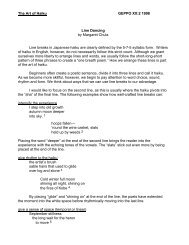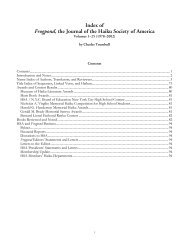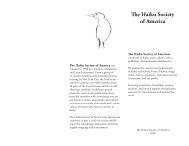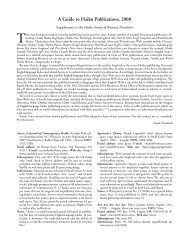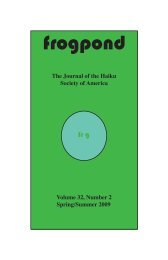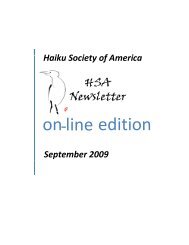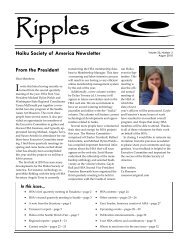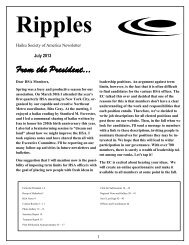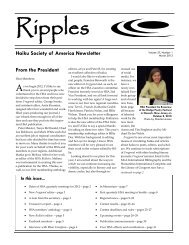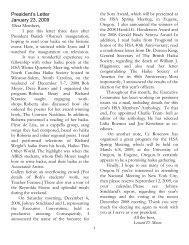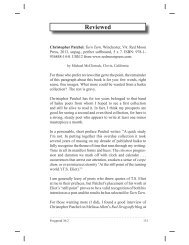Frogpond 34.3 • Autumn 2011 (pdf) - Haiku Society of America
Frogpond 34.3 • Autumn 2011 (pdf) - Haiku Society of America
Frogpond 34.3 • Autumn 2011 (pdf) - Haiku Society of America
Create successful ePaper yourself
Turn your PDF publications into a flip-book with our unique Google optimized e-Paper software.
A three-line haiku <strong>of</strong>ten segments the image, or images, it<br />
contains, but when we feel poets are working consciously with<br />
this technique we place more trust in them:<br />
summer sales<br />
a Caravaggio<br />
chalked on the kerb 6<br />
The “Caravaggio/chalked on the kerb” in Matthew Paul’s<br />
haiku is a single image yet the poet breaks the line to slow us<br />
down in our reading. When we read “Caravaggio” master paintings<br />
come to mind, but the following line reverses our expectation.<br />
This is the work <strong>of</strong> a street artist, although not something<br />
we might appreciate any less. In fact, the skill and location <strong>of</strong><br />
these works <strong>of</strong>ten have more power to attract us than paintings<br />
held in museums. When we read the haiku again the fracture<br />
created by the line break invites us to ponder on the ideas <strong>of</strong><br />
value and greatness, and on what can be bought and sold.<br />
In contrast, John Barlow lays out his imagery in a more traditional<br />
manner:<br />
out between showers<br />
her milk tooth grin<br />
wobbling with her bicycle 7<br />
The poet wants us to experience the break between showers<br />
before we see the child’s smile and before we see her learning<br />
to ride her bicycle. The order <strong>of</strong> perception 8 is important:<br />
knowing the child is young (“milk tooth”) impacts on our<br />
emotional response to the final line. There is tenderness and<br />
there is unease, in the subject <strong>of</strong> the haiku, in the viewer <strong>of</strong> the<br />
scene and in the reader. Once we have experienced the haiku<br />
in its parts we go back and absorb it as a whole and the concrete<br />
imagery—the breaks between showers, a child’s shaky<br />
smile during the rite <strong>of</strong> passage <strong>of</strong> learning to ride a bike—<br />
takes on the deeper significance about parenting and releasing<br />
a child into the world.<br />
6. To introduce a dramatic effect, e.g., misdirection, tem-<br />
porary ambiguity, hesitancy.<br />
. . . . . . . . . . . . . . . . . . . . . . . . . . . . . . . . . . . . . . . . . . . . . . . . . . . . . . . . . . . .<br />
<strong>Frogpond</strong> 34:3 75



